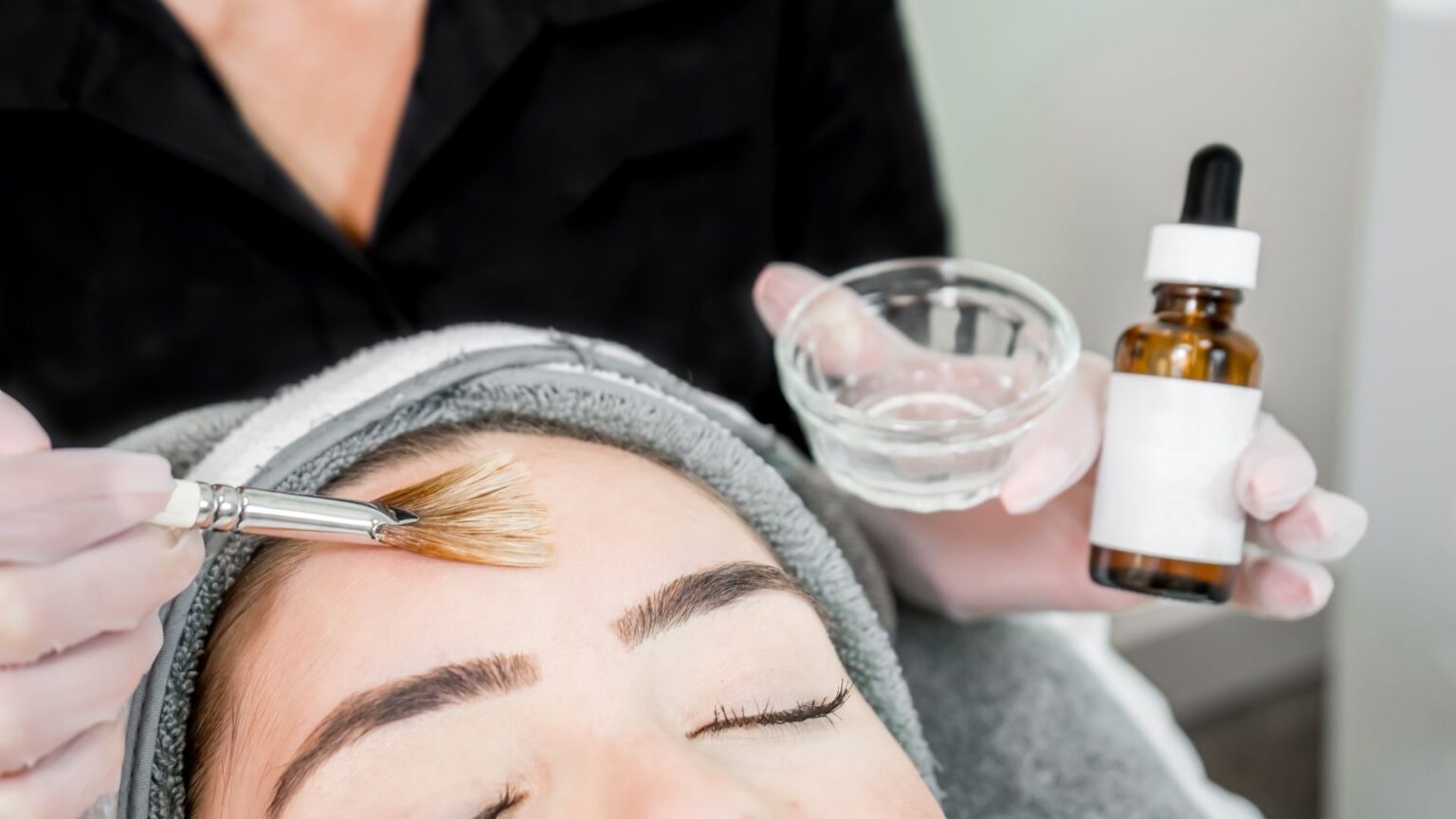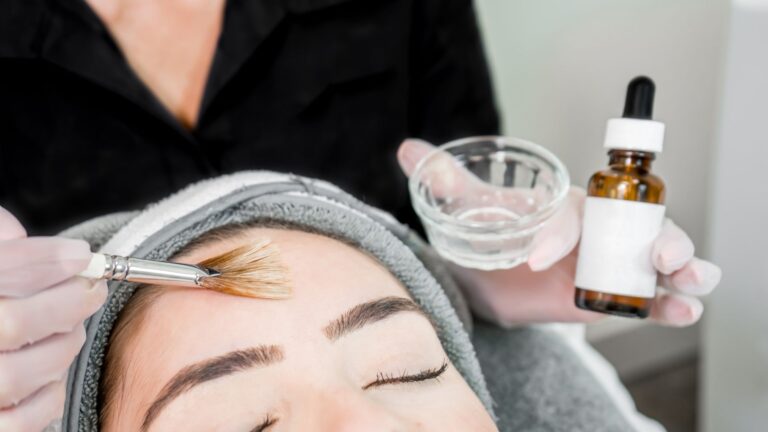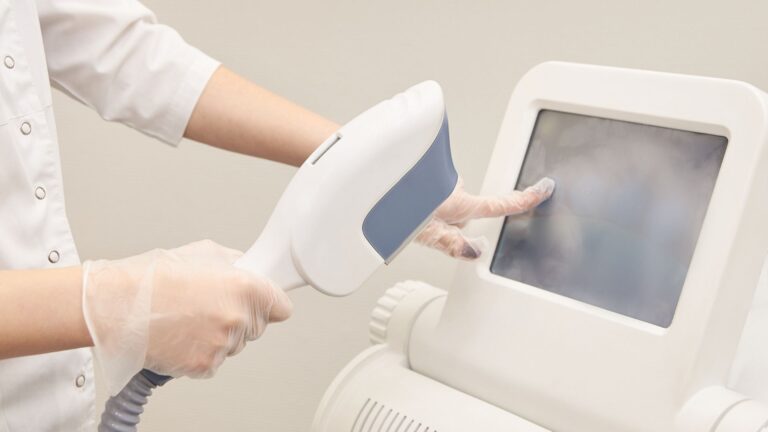Chemical peels are cosmetic procedures that exfoliate the skin with fruit acids.
The fruit acids dissolve an even layer of damaged skin cells throughout the treatment region. When performed correctly, chemical peels should not cause scarring or discoloration of the skin.
Chemical peels disrupt the bonds that hold skin cells together in the epidermis and dermis layers of the skin. The epidermis is the outermost visible layer, whereas the dermis lies beneath. Nerve endings, sweat glands, and hair follicles are located in the deeper dermal layer.
All chemical peels exfoliate the epidermis by removing a regulated amount of skin cells. Additionally, a more intense peel or deeper peel may remove a tiny portion of the dermis.
Types Of Chemical Peels
Chemical peels are classified into three types based on how deep they exfoliate the skin:
Superficial peels
Medium-depth peels
Deep peels
The best recommendation is to visit a board-certified dermatologist to determine the safest chemical peels for your skin type and color. Persons with dark (black or brown skin) should seek the expertise of a skin-of-color dermatologist. Skin-of-color dermatologists have experience in treating darker complexions with chemical peels.
Superficial peels
Dermatologists prescribe superficial peels to treat concerns affecting the epidermis. Examples are mild skin discoloration, acne, or rough skin texture.
Because superficial peels do not penetrate the deeper layers of the skin, they are associated with a decreased risk of side effects and a faster skin recovery.
Superficial peels heal in 1–7 days. It is critical to protect the skin from sun exposure during this period.
Due to the delicate nature of superficial peels, a person may require up to six sessions to achieve the desired results. Individuals may be able to receive superficial peels every two to five weeks.
Medium-depth Peels
Dermatologists may advise medium-depth peels for the following conditions:
fine lines and wrinkles
minor hyperpigmentation
minor acne scars
sun-damaged skin
Peels with a medium depth take 7–14 days to heal. They produce swelling that worsens for 48 hours following therapy and may result in blisters and scabs.
The dermatologist prescribes a topical treatment to aid in the healing process. Additionally, it is critical to prevent sun exposure during the recuperation period.
Further, notify the doctor if you have a history of cold sores or herpes simplex infections on your lips (face). The dermatologist may prescribe oral antiviral medicine to prevent eruptions of latent cold sores. After 5–7 days, individuals may resume wearing cosmetics but must avoid prolonged sun exposure until the skin has completely healed.
Deep Peels
Dermatologists rarely conduct deep chemical peels. When it comes to issues impacting the deeper layers, laser therapy frequently produces superior outcomes.
However, a dermatologist may recommend a deep peel if a patient has the following conditions:
moderate to severe sunburns
moderate to severe wrinkles
moderate to severe hyperpigmentation
Deep peels take 14–21 days to recover due to their intensity. A person must:
Recuperate in the comfort of their own home.
Take oral antiviral medication if they have a history of cold sores.
Wash the skin with a specific solution between four and six times per day.
Apply a healing ointment for 14 days to facilitate healing.
For at least 14 days, refrain from wearing makeup.
For 3–6 months, try to reduce sun exposure.
Chemical peels can help prevent further damage to the skin, giving it a more youthful or unblemished appearance. A dermatologist will determine the most appropriate chemical peel for patients based on their specific concerns and skin type.
Superficial peels are the least invasive and are suitable for all skin types. However, every chemical peel has some downtime/recovery time. Chemical peels may result in adverse effects such as redness, skin peeling, and sun sensitivity if aftercare directions are not followed properly.
OTC chemical peel products contain weaker versions of the chemical peeling agents. They are significantly less expensive than professional peels but take significantly longer to work.
Side Effects Of Chemical Peels
Chemical peels can have mild side effects. However, some people experience long-term negative consequences, such as:
Months-long redness
Dark areas of skin that are temporary
Permanently lightened patches of skin
Dark areas of skin that are permanent
The best way to avoid these complications is to consult a board-certified dermatologist and carefully follow their post-treatment advice.
Professional vs. At-Home Treatments
It is critical to select a board-certified dermatologist with experience using chemical peels. This is especially critical for persons of color, whose skin may be more susceptible to chemical peel adverse effects.
The dermatologist will discuss which type of peel is appropriate for the patient’s skin and which items will aid in healing following the procedure.
Professional treatments, which contain higher doses of fruit acids than OTC versions, may provide better outcomes for individuals with more severe skin issues.
However, the cost may be a factor. Superficial peels are more affordable, whereas a medium-depth peel will cost more. According to the American Society of Plastic Surgeons, the average cost of a chemical peel is $644. Chemical peels are not covered by insurance because they are considered cosmetic treatments.
While at-home products are less expensive, they include weaker chemical solutions. These may be more appropriate for individuals with mild skin issues, such as minor sun damage.
While these OTC chemical peel solutions do not require downtime for healing, it is still critical to prevent excessive sun exposure.
Even when used by professionals, strong acids can have significant adverse effects. Never use clinical-strength chemical peeling agents at home.
Even components in OTC chemical peels that are less potent might cause burns if misused. Use them with caution and carefully follow the directions.

Adebola Dele-Michael, MD
After helping thousands of people with skin and hair challenges, Adebola Dele-Michael, MD covered a wide range of topics in the skin and hair industries. Her mission is to fill the knowledge gap in caring for hair and skin of color.





